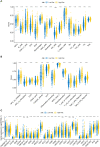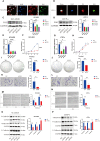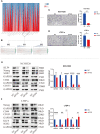Identification of specific prognostic markers for lung squamous cell carcinoma based on tumor progression, immune infiltration, and stem index
- PMID: 37841237
- PMCID: PMC10570622
- DOI: 10.3389/fimmu.2023.1236444
Identification of specific prognostic markers for lung squamous cell carcinoma based on tumor progression, immune infiltration, and stem index
Abstract
Introduction: Lung squamous cell carcinoma (LUSC) is a unique subform of nonsmall cell lung cancer (NSCLC). The lack of specific driver genes as therapeutic targets leads to worse prognoses in patients with LUSC, even with chemotherapy, radiotherapy, or immune checkpoint inhibitors. Furthermore, research on the LUSC-specific prognosis genes is lacking. This study aimed to develop a comprehensive LUSC-specific differentially expressed genes (DEGs) signature for prognosis correlated with tumor progression, immune infiltration,and stem index.
Methods: RNA sequencing data for LUSC and lung adenocarcinoma (LUAD) were extracted from The Cancer Genome Atlas (TCGA) data portal, and DEGs analyses were conducted in TCGA-LUSC and TCGA-LUAD cohorts to identify specific DEGs associated with LUSC. Functional analysis and protein-protein interaction network were performed to annotate the roles of LUSC-specific DEGs and select the top 100 LUSC-specific DEGs. Univariate Cox regression and least absolute shrinkage and selection operator regression analyses were performed to select prognosis-related DEGs.
Results: Overall, 1,604 LUSC-specific DEGs were obtained, and a validated seven-gene signature was constructed comprising FGG, C3, FGA, JUN, CST3, CPSF4, and HIST1H2BH. FGG, C3, FGA, JUN, and CST3 were correlated with poor LUSC prognosis, whereas CPSF4 and HIST1H2BH were potential positive prognosis markers in patients with LUSC. Receiver operating characteristic analysis further confirmed that the genetic profile could accurately estimate the overall survival of LUSC patients. Analysis of immune infiltration demonstrated that the high risk (HR) LUSC patients exhibited accelerated tumor infiltration, relative to low risk (LR) LUSC patients. Molecular expressions of immune checkpoint genes differed significantly between the HR and LR cohorts. A ceRNA network containing 19 lncRNAs, 50 miRNAs, and 7 prognostic DEGs was constructed to demonstrate the prognostic value of novel biomarkers of LUSC-specific DEGs based on tumor progression, stemindex, and immune infiltration. In vitro experimental models confirmed that LUSC-specific DEG FGG expression was significantly higher in tumor cells and correlated with immune tumor progression, immune infiltration, and stem index. In vitro experimental models confirmed that LUSC-specific DEG FGG expression was significantly higher in tumor cells and correlated with immune tumor progression, immune infiltration, and stem index.
Conclusion: Our study demonstrated the potential clinical implication of the 7- DEGs signature for prognosis prediction of LUSC patients based on tumor progression, immune infiltration, and stem index. And the FGG could be an independent prognostic biomarker of LUSC promoting cell proliferation, migration, invasion, THP-1 cell infiltration, and stem cell maintenance.
Keywords: LUSC; biomarker; cancer stem cell; prognosis; tumor microenvironment.
Copyright © 2023 Wu, Ma, Duan, Zhang, Li, Yu, Zhang, Liu and Wang.
Conflict of interest statement
The authors declare that the research was conducted in the absence of any commercial or financial relationships that could be construed as a potential conflict of interest.
Figures










Similar articles
-
Significance of NKX2-1 as a biomarker for clinical prognosis, immune infiltration, and drug therapy in lung squamous cell carcinoma.PeerJ. 2024 May 1;12:e17338. doi: 10.7717/peerj.17338. eCollection 2024. PeerJ. 2024. PMID: 38708353 Free PMC article.
-
Cancer Stemness-Based Prognostic Immune-Related Gene Signatures in Lung Adenocarcinoma and Lung Squamous Cell Carcinoma.Front Endocrinol (Lausanne). 2021 Oct 21;12:755805. doi: 10.3389/fendo.2021.755805. eCollection 2021. Front Endocrinol (Lausanne). 2021. PMID: 34745015 Free PMC article.
-
A 13-gene signature to predict the prognosis and immunotherapy responses of lung squamous cell carcinoma.Sci Rep. 2022 Aug 11;12(1):13646. doi: 10.1038/s41598-022-17735-6. Sci Rep. 2022. PMID: 35953696 Free PMC article.
-
The Effect of GLUT1 on the Survival Rate and Immune Cell Infiltration of Lung Adenocarcinoma and Squamous Cell Carcinoma: A Meta and Bioinformatics Analysis.Anticancer Agents Med Chem. 2022;22(2):223-238. doi: 10.2174/1871520621666210708115406. Anticancer Agents Med Chem. 2022. PMID: 34238200 Review.
-
Differences between lung adenocarcinoma and lung squamous cell carcinoma: Driver genes, therapeutic targets, and clinical efficacy.Genes Dis. 2024 Jul 11;12(3):101374. doi: 10.1016/j.gendis.2024.101374. eCollection 2025 May. Genes Dis. 2024. PMID: 40083325 Free PMC article. Review.
Cited by
-
Bioinformatics Analysis Reveals HIST1H2BH as a Novel Diagnostic Biomarker for Atrial Fibrillation-Related Cardiogenic Thromboembolic Stroke.Mol Biotechnol. 2025 May;67(5):2111-2126. doi: 10.1007/s12033-024-01187-6. Epub 2024 Jun 2. Mol Biotechnol. 2025. PMID: 38825608
-
Expression profiles and clinical significance of cystatin family genes in transitional cell carcinoma of the urinary bladder.Bladder (San Franc). 2025 Mar 13;12(1):e21200035. doi: 10.14440/bladder.2024.0057. eCollection 2025. Bladder (San Franc). 2025. PMID: 40747123 Free PMC article.
-
Development of m6A/m5C/m1A regulated lncRNA signature for prognostic prediction, personalized immune intervention and drug selection in LUAD.J Cell Mol Med. 2024 Apr;28(8):e18282. doi: 10.1111/jcmm.18282. J Cell Mol Med. 2024. PMID: 38647237 Free PMC article.
-
Factors affecting chemotherapy-induced nausea and vomiting in patients with lung squamous cell carcinoma.Am J Transl Res. 2025 Jul 15;17(7):5129-5140. doi: 10.62347/FZAJ6796. eCollection 2025. Am J Transl Res. 2025. PMID: 40821046 Free PMC article.
-
AKAP12, mediated by transcription factor 21, inhibits cell proliferation, metastasis, and glycolysis in lung squamous cell carcinoma.Open Life Sci. 2025 Apr 9;20(1):20220912. doi: 10.1515/biol-2022-0912. eCollection 2025. Open Life Sci. 2025. PMID: 40226362 Free PMC article.
References
Publication types
MeSH terms
Substances
LinkOut - more resources
Full Text Sources
Medical
Miscellaneous

